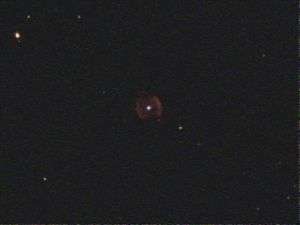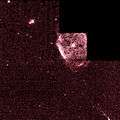NGC 40
For the Bow Tie Nebula in Centaurus, see Boomerang Nebula.
| Nebula | |
|---|---|
 | |
| Observation data: J2000 epoch | |
| Right ascension | 00h 13m 01.015s[1] |
| Declination | +72° 31′ 19.085″[1] |
| Distance | ~3,500 ly (~1.0 kpc)[2] ly |
| Apparent magnitude (V) | 10.7,[1] 11.6[2] |
| Apparent dimensions (V) | 38 x 35 arcseconds[2] |
| Constellation | Cepheus |
| Designations | Bow-Tie Nebula, Caldwell 2 |
NGC 40 (also known as the Bow-Tie Nebula and Caldwell 2) is a planetary nebula discovered by William Herschel on November 25, 1788, and is composed of hot gas around a dying star. The star has ejected its outer layer which has left behind a smaller, hot star with a temperature on the surface of about 50,000 degrees Celsius.[3] Radiation from the star causes the shed outer layer to heat to about 10,000 degrees Celsius,[3] and is about one light-year across.[3] About 30,000 years from now, scientists theorize that NGC 40 will fade away, leaving only a white dwarf star approximately the size of Earth.[3]
Gallery
References
External links
- NGC 40 on WikiSky: DSS2, SDSS, GALEX, IRAS, Hydrogen α, X-Ray, Astrophoto, Sky Map, Articles and images
Coordinates: ![]() 00h 13m 01s, +72° 31′ 19″
00h 13m 01s, +72° 31′ 19″
This article is issued from Wikipedia - version of the 6/27/2016. The text is available under the Creative Commons Attribution/Share Alike but additional terms may apply for the media files.
